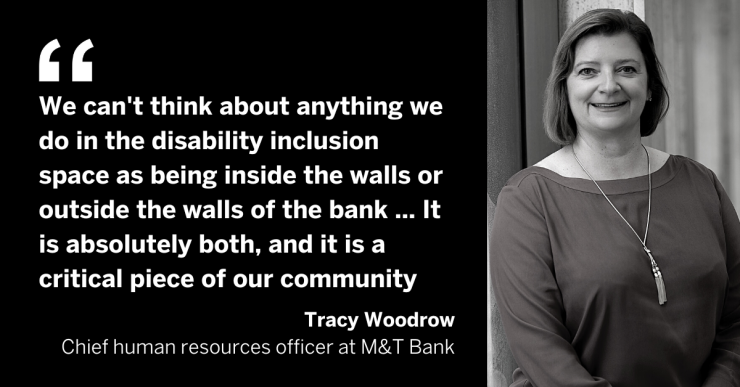M&T Bank is harnessing feedback generated by employees with disabilities to better address accessibility concerns across the organization.
Following the launch of its first
The Disability Advocacy Network (DAN) group, founded in 2012, provides support for employees who either have a disability or are caretakers for such persons. The group offers training programs and accessibility reviews of physical facilities, while also advocating for increased awareness of conditions such as autism and many others.
David Zolnowski, senior vice president at the $204 billion-asset M&T, was approached to take on the mantle of president for the DAN group more than five years ago based on his experience as a parent of a child with a disability.

"In addition to being a senior vice president here, I'm also the father of an amazing 24-year-old boy, Patrick, who was born with Down syndrome," Zolnowski said. "When he was born, my wife and I really started down the journey of how we can not only help individuals with disabilities, but also the parents and caregivers of individuals with disabilities."
Throughout his tenure as the group's leader, Zolnowski has overseen initiatives to expand its reach. It extended support to customers with disabilities through initiatives such as the company's implementation of MagnusCards, an app that hosts digitized story experiences for guiding individuals with autism or cognitive disorders through transacting with M&T, as well as everyday moments in life.
Additionally, the bank's
"As I help him navigate through his life at this point in time, it's really important to make sure that we're dealing on a personal level with organizations that understand the struggles that we're going through and provide us the tools and the resources that we need to be able to effectively advocate and help our son," Zolnowski said. "To know that M&T does that and to be able to communicate to other parents and other caregivers that we do care and we have a framework in place to help our employees and customers with disabilities succeed, it means a lot to the parent, and they seek out organizations who have demonstrated that."
As part of the bank's ongoing efforts for increasing the accommodations and resources available to those living with various conditions, M&T began organizing conversations with employees through monthly Share-a-Story gatherings and Ideation Sessions as spaces for exploring personal experiences on topics ranging from depression, anxiety and accessibility issues, to specific conditions such as autism, cerebral palsy and multiple sclerosis.
"Our mission at M&T is to be the bank of choice for diverse customers in every community we serve, be a workplace where our colleagues truly feel like they belong and can be their authentic selves and create diverse leadership pipelines at all levels to reflect our broader employee base and our communities," said Tracy Woodrow, chief human resources officer at M&T.
Woodrow stressed that arming employees with the necessary resources for interacting with those who have a disability can improve how effective the bank is in engaging with the surrounding environment.

"We can't think about anything we do in the disability inclusion space as being [either] inside the walls or outside the walls of the bank … It is absolutely both, and it is a critical piece of our community," Woodrow said.
Whether through industry partnerships with firms such as CU Strategic Planning or annual participation in campaigns similar to the
Experts with The Autism Society of America, a nonprofit helping connect individuals with autism and their families with the resources necessary to effectively navigate their lives, agree that employers should actively seek guidance and support from autistic individuals, community members and organizational partners when reviewing such initiatives.
"In professional and non-professional settings, the majority of employers lack an understanding of autism that contributes to the marginalization of the autistic workforce … Employers contribute to the problem by not actively seeking neurodiverse employees [or by being unsure and unwilling] to prioritize neurodiverse employment programs to instill a culture of meaningful support," said Kristyn Roth, chief marketing officer of the Autism Society.
In appointing neurodiverse people and others living with a disability, financial institutions can change the misconception surrounding employment of such individuals from their hiring being a charitable act to a competitive advantage, Roth said.
"Employers see productivity gains, quality improvement, increased innovation, creativity and employee engagement and overall inclusion that leads to improved organizational culture," Roth said. "Employees are gainfully employed, earning an income, creating connections, building confidence and increasing quality of life."






